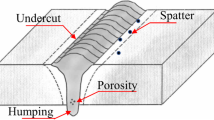Abstract
Numerous examples of practical use in industry of the Thixomet image analyzer for quantitative description of the microstructure of steels and alloys have been described. More than 200 image analyzers have been installed at Universities, R&D labs, and plants during the twenty years of the Thixomet’s history. Sixty-five Thixomet plug-ins cover all Russian and most of International standards. The techniques of quantitative description of non-metallic inclusions, grain size, and all kinds of microstructural inhomogeneity in modern pipeline steels (such as microstructure banding, general anisotropy, blocks of a bainite with lath morphology, centerline segregation) have been developed, realized, and put into practice as a motorized hardware–software complex, Thixomet SmartDrive, at many enterprises. It was established that structural inhomogeneity evaluated by volume fraction and a blocks length of a bainite with lath morphology elongated along the rolling direction adequately described the mechanical properties of pipeline steels. The name of Thixomet was taken because of Greek “Thixis” (touch) and “Metrisi” (measurement), so an idea is “One Touch Measurement.” Measurement operations from capturing an image up to a generation of quantitative description of a structure as a report are actually performed by several evident actions that confirm the name of the product. Thixomet has succeeded in international interlaboratory Round Robin Test Programs and performed with the good results across worldwide Image Analysis systems. This was a cause to get an official metrological certificate from Russian State Metrological Committee which certified Thixomet as a measurement tool.







Similar content being viewed by others
References
A.A. Kazakov, N.H. Luong, Characterization of semi-solid materials structure. Mater. Charact. 46, 155–161 (2001)
A. Kazakov, D. Kiselev, Metallurgical quality characterization of nickel based superalloys. CIS Iron Steel Rev. 1–2, 40–43 (2007)
Kazakov A.A. et al., Quantitative description of microstructure for structure-property relationships of pipeline plate steel. CIS Iron Steel Rev. 4–12 (2012)
A.A. Kazakov et al., Image analysis characterization of modern pipe steels structures. Microsc. Microanal. 17(Suppl. 2), 1024–1025 (2011)
A.A. Kazakov et al., Structure inhomogeneity and failure analysis of modern pipe steels. Microsc. Microanal. 17(Suppl. 2), 1744–1745 (2011)
A. A. Kazakov et al., The method of examination of pipeline steels structure, RF Patent № 2449055, 18 October 2010
Author information
Authors and Affiliations
Corresponding author
Additional information
This article is an invited paper selected from presentations at the 2015 Microscopy & Microanalysis Conference, held August 2–6, 2015, in Portland, Oregon, USA, and has been expanded from the original presentation.
Rights and permissions
About this article
Cite this article
Kazakov, A.A., Kiselev, D. Industrial Application of Thixomet Image Analyzer for Quantitative Description of Steel and Alloy's Microstructure. Metallogr. Microstruct. Anal. 5, 294–301 (2016). https://doi.org/10.1007/s13632-016-0289-6
Received:
Revised:
Accepted:
Published:
Issue Date:
DOI: https://doi.org/10.1007/s13632-016-0289-6




